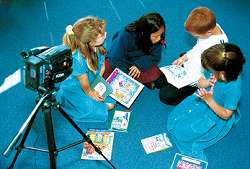|
The assessments
included eight tasks which involved students in reading out loud for
purposes of entertaining, sharing information and reaching decisions.
 Two
of the tasks were identical for year 4 and year 8 students. The other
six tasks were in effect three pairs of tasks. Each pair had similar
instructions, marking procedures, and marking criteria, but differed
in the stimulus materials used. Two
of the tasks were identical for year 4 and year 8 students. The other
six tasks were in effect three pairs of tasks. Each pair had similar
instructions, marking procedures, and marking criteria, but differed
in the stimulus materials used.
Two of the tasks
are link tasks (to be used again in the year 2000) and therefore are
not described in detail here. The other tasks are released tasks for
which full details are given.
The chapter presents
the assessment results in the following order:
• the released tasks
attempted by both year 4 and year 8 students;
• the released tasks attempted separately by year 4 and year 8 students;
• the two tasks which will be used as link tasks.
Results in the tasks requiring
oral presentation and dramatisation of written material show very little
difference on most dimensions of performance between year 4 and year
8 students. In some cases, year 4 results are marginally higher than
year 8 results. This in part might suggest that many year 4 students
tend to be more spontaneous and less constrained by normative peer expectations
than their year 8 counterparts when working in group interactive situations.
It may also be that year 4 students engage more often in the types of
activities presented in the tasks.
Skilfulness in reading, interpreting
and describing of a range of visual information from everyday environments
was consistently higher at year 8 than year 4.
When presented with a selection
of fiction books written by popular authors, both year 4 and year 8 students
nominated a fairly even distribution of titles of preferred books. However,
a higher percentage of year 8 than year 4 students was able to skilfully
justify and explain their preference for one book over others.
|